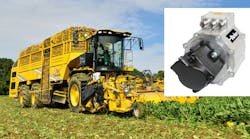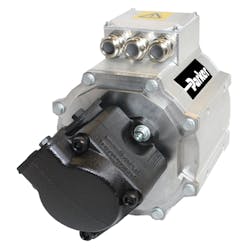Diesel and gas engines still reign supreme for powering most heavy equipment. Smaller vehicles—especially those working indoors—often rely on battery packs to power electric motors. However, advances in electric motors and improvements in battery power storage and quicker charging times have led to increasingly larger, more powerful electric and hybrid vehicles.
Using a high-efficiency electric motor to drive a matching hydraulic pump can provide a drive package that conserves battery power while also supplying plenty of hydraulic power to actuators. Once such package is the electro-hydraulic pump (EHP) system from Parker Hannifin. The EHP system is designed for hybrid electric and any mobile application requiring power from an electric motor. The system consists of an electric motor directly coupled to a hydraulic pump controlled by an electric drive designed for mobile equipment—a mobile-hardened drive, as Parker calls it. Sizing and selecting the required EHP involves specifying just three parameters: flow, pressure, and voltage.
Parker Hannifin’s EHP system for mobile applications breaks from convention by using a low-inertia electric motor to drive a machine’s hydraulic pump.
The standard system consists of a low- or high-voltage electrical drive, low-voltage induction or synchronous motor, and hydraulic pump. Parker’s T7 fixed-displacement vane is standard, but other pump designs can be used on request. The pre-engineered system comes fully validated for pressure, flow, and voltage requirements. The motor series operates from a wide range of voltage ranges to accommodate a variety of battery packs. The electrical drive, motor, and pumps mechanically matched, making a compact package that does not require extra adapters.
Potential applications include electric power steering systems; construction, agricultural, and material-handling equipment; street sweepers; work trucks; utility vehicles; refuse trucks; and auxiliary hydraulic systems in buses and vocational vehicles.
Click here to download a PDF detailing Parker’s electro-hydraulic pump.



